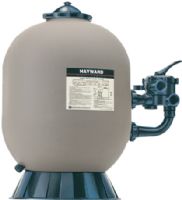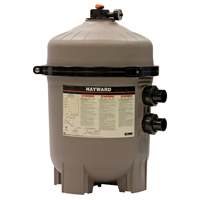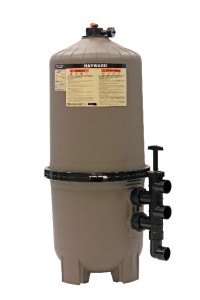Pool Filter Service
A pool can be properly maintained with any of the filter systems available
Swimming Pool Filter Service And Repair A new filter may be in order if your current filter is outdated (15 – 20 yrs old) and difficult to use or get parts for. If the filter tank has cracked a new filter is in order.
3 main types of swimming pool filters,
- Sand – The bullet proof filter
- Cartridge – The economic low maintenance filter.
- DE – The water polisher.
There is a lot of confusion about various filters, and many different opinions. Here are a few facts to consider. The first is that a pool can be properly maintained with any of the filter systems available: Sand, Cartridge, or Diatomaceous Earth (DE). Here is a brief description of each type:
Sand – The bullet proof filter
 Water is pushed through a bed of filter sand and removed through a set of lateral tubes at the bottom. The filter area of a sand filter is equal to the area of the filter itself. For example, a 24” filter will have 3.14 sqft of filter area. Only the top 1” of sand is actually used to filter the water. The principle behind this filter is that water is pushed through the filter sand, somewhat like an espresso machine. Dirty water goes in the top and clean water exits out the bottom. As the filter sand becomes plugged with debris from the pool, the pressure increases on the filter and the water flow drops. In order to clean the filter, you just run it in reverse and dump the waste water; this is referred to as “backwashing” the filter. Once the filter is backwashed, you move to the rinse mode and that repacks the sand and then back to filter. This has to be done manually every few weeks. From a hydraulics standpoint, a backwash valve is typically the most inefficient piece of equipment you can add to a swimming pool system. Should the sand ever become really dirty, it is easily and inexpensively replaced. In terms of particle size filtered out, sand is the lease effective method – it can allow smaller particles to pass back into the pool.
Water is pushed through a bed of filter sand and removed through a set of lateral tubes at the bottom. The filter area of a sand filter is equal to the area of the filter itself. For example, a 24” filter will have 3.14 sqft of filter area. Only the top 1” of sand is actually used to filter the water. The principle behind this filter is that water is pushed through the filter sand, somewhat like an espresso machine. Dirty water goes in the top and clean water exits out the bottom. As the filter sand becomes plugged with debris from the pool, the pressure increases on the filter and the water flow drops. In order to clean the filter, you just run it in reverse and dump the waste water; this is referred to as “backwashing” the filter. Once the filter is backwashed, you move to the rinse mode and that repacks the sand and then back to filter. This has to be done manually every few weeks. From a hydraulics standpoint, a backwash valve is typically the most inefficient piece of equipment you can add to a swimming pool system. Should the sand ever become really dirty, it is easily and inexpensively replaced. In terms of particle size filtered out, sand is the lease effective method – it can allow smaller particles to pass back into the pool.
The average Sand Filters sand bed should be replaced after seven years. Gradual loss of efficiency may be hard to notice. If your filter requires frequent backwashing, (every week or two), the sand bed may be “mudballed”, or it may be “channeled”. It may also “calcify” from calcium deposits.
Sand filter tanks rarely leak themselves. A common complaint is that water is leaking out of the backwash port of the multiport (six position) valve. The filter may have a push-pull valve, or slide valve, instead of a multiport valve. Leaks can occur through the top of the index plate, or out of the backwash line. An inspection to determine what o-rings need to be replaced. Leaks can also occur at the bulkhead unions where the valve attaches to the side of the filter, or around the threads on a top-mounted multiport. The drain plug can leak if not secured tightly or properly sealed.
Cartridge – The economic low maintenance filter.
 This one is easy to understand. Water passes though a filter material and the filter captures the debris. This is just like the water filters used under your sink. Cartridges have much more available area to filter than sand. Most start at 100 sqft and the majority of the cartridge filters sold are larger than 300 sqft. So they don’t clog up as quickly and therefore you touch them less frequently. There are two types of cartridge filters in general. In the first case, there are filters elements that are inexpensive to replace and as such, they don’t tend to last as long. Then there are other filters that have very expensive elements and these last 5 or more years. In both cases, cartridge filters are designed to run at lower pressure than sand. This puts less back-pressure on the pump and hence you get more flow and turnover for an equivalent pump size. Generally these filters have to be cleaned once or twice a season by simply hosing them off, so you don’t touch them as often. In terms of particle size filtered out, cartridge is somewhere between sand and DE.
This one is easy to understand. Water passes though a filter material and the filter captures the debris. This is just like the water filters used under your sink. Cartridges have much more available area to filter than sand. Most start at 100 sqft and the majority of the cartridge filters sold are larger than 300 sqft. So they don’t clog up as quickly and therefore you touch them less frequently. There are two types of cartridge filters in general. In the first case, there are filters elements that are inexpensive to replace and as such, they don’t tend to last as long. Then there are other filters that have very expensive elements and these last 5 or more years. In both cases, cartridge filters are designed to run at lower pressure than sand. This puts less back-pressure on the pump and hence you get more flow and turnover for an equivalent pump size. Generally these filters have to be cleaned once or twice a season by simply hosing them off, so you don’t touch them as often. In terms of particle size filtered out, cartridge is somewhere between sand and DE.
Each time the filter is cleaned, some of its filtering ability is reduced. The cartridge should be replaced every 2 – 5 yrs, depending on the work it was asked to do. If the filter was a bit undersized, and had some algae every year and lots of tree debris, etc. then it may last only 1 – 2 years. Properly sized cartridge filters can operate for 6-12 months between cleanings. If you see sand or D.E. Powder returning to your pool, you may have broken internal parts that need replacing.
DE – The water polisher.
 Diatomaceous earth is mined and is the fossilized exoskeletons of tiny diatoms. They are used to coat “grids” in the filter housing and act as tiny sieves to remove debris. They are very small and as such can filter out particles as small as 5 microns. Diatom filter area are sized between sand and cartridge – around 60-70 sqft are most common. Once the filter pressure rises, the filter is backwashed just like a sand filter and then “recharged” with more DE powder. Typically it is poured in a slurry into the skimmer and it then coats the filter grids. DE filters run at higher pressures than cartridge filters and as such can lead to some inefficiency and flow loss.
Diatomaceous earth is mined and is the fossilized exoskeletons of tiny diatoms. They are used to coat “grids” in the filter housing and act as tiny sieves to remove debris. They are very small and as such can filter out particles as small as 5 microns. Diatom filter area are sized between sand and cartridge – around 60-70 sqft are most common. Once the filter pressure rises, the filter is backwashed just like a sand filter and then “recharged” with more DE powder. Typically it is poured in a slurry into the skimmer and it then coats the filter grids. DE filters run at higher pressures than cartridge filters and as such can lead to some inefficiency and flow loss.
The D.E. filter is the most efficient type of pool filter on the market. It can trap particles down to 3 – 5 microns; well below what the naked eye can see. As with sand filters, the pressure gauge indicates a need for backwashing. After backwashing a D.E. filter, a new application of D.E. powder is added to the filter. An annual breakdown of the filter is necessary to thoroughly clean and inspect D.E. filter grids.
The D.E. powder is what filters your pool water in a D.E. filter. Do not operate your pump without having the D.E. powder coating the grids, or you will see your pressure rise very quickly, and if left in this manner the grids could become damaged. The Cartridge filters element, an aquatic version of the pleated air cleaner in your car, traps dirt and particles of 25 – 100 microns in size.
Which type of swimming pool filter system is best? First you must define best!
Now with that background, which filter is best? I often use this question to gauge who I am talking to in a pool store. Just ask: “Which filter is best” and then listen for the answer. There is only one correct answer to that question: can you please define best? If the answer is any of the three, someone is trying to simply sell you something.
- If you want bulletproof – sand is a great choice.
- Low maintenance would lead one to cartridge.
- The cleanest water might lead you to DE.
- All filters work.
- You can add a little DE to a sand or cartridge filter to increases its ability to filter small particles.
- Flocculants can be added to the pool water to create big particles out of small particles (think – flocks of birds are easier to see).
- Cartridges that become fouled can be replaced.
My recommendations? I would go with a high-end cartridge filter. The reason is that no one really wants to have another item on the to-do list and good cartridge filter can last a season. Be sure that you:
- Plumb a line into the drain port with a ball valve, so that you can bypass the filter when you are vacuuming the pool to waste.
- Use a little DE powder (1 or 2 coffee cans full in the skimmer) to really polish the water or just add a flocculent every now and then.
- Take a look at the filter housing design. You may want to consider how easy the filter is to access and clean.
- Keep in mind that the more square feet of cartridge, the less often you touch it.
- Never use a car wash wand to wash the filter. A hose with a sprayer will work fine.



